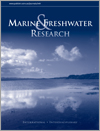Marine and Freshwater Research
Volume 74
Number 6 2023
This paper presents growth and mortality estimates for tailor (Pomatomus saltatrix) off eastern Australia. The population has a fast growth rate with a high mortality rate. These are generally similar to those in other global populations of P. saltatrix, except in the north-western Atlantic population, which shows lower mortality and regularly gets older and larger individuals.
The health of coral reefs is declining rapidly because of human impacts, especially of those close to population centres. We surveyed the coral reefs at a remote, uninhabited island group in Indonesia, which were expected to be less damaged. We found reasonably healthy coral reefs and importantly, very healthy fish stocks with many large predatory species. Our study suggested that Lucipara’s reefs are among the healthiest in Indonesia and should be protected in a time of declining coral-reef health.
Mean and extreme stream temperatures are projected to rise, affecting the organisms that inhabit streams. Examining the temperature that causes the death of Australian freshwater shrimp gives some insight into the impacts of the increasing temperatures. Our results identified a potential vulnerability of stream invertebrates to stream temperature increases because they may be living close to their limits.
This study evaluated the different stages of degradation of plastic items found throughout the Capibaribe River estuary. In total, 381 macroplastics (plastic >25 mm in size) and 1757 microplastics (plastic <5 mm in size) were found. Most of the plastics found presented an advanced stage of degradation, with alteration in colour, and were hardened and brittle. The plastics are retained in this environment and can cause negative consequences for the organisms that live there.
Accuracy in species identification is a crucial factor for the quality of biodiversity studies and species management. The present study evaluated portable near-infrared spectroscopy combined with machine learning through a neural network to identify species of Decapoda. Our technique identified all species with 100% accuracy, paving the way for the development of tools for the precise and inexpensive separation among species by non-specialists or for those that require the identification of a large number of individuals.
Tropical coastal waters are experiencing warming and nutrient enrichment, and these environmental changes increased both bacterial and virus production. Nutrient enrichment increased virus production and resulted in a stronger virus top-down control on bacterial production. Therefore, eutrophication will drive the ecosystem towards heterotrophy.
The growing demand for global food security has resulted in a rise in fishing intensity and the overexploitation of fish resources, including tuna. Increasingly, fishers are using different methods to improve efficiencies and reduce costs. However, some approaches may have unintended consequences for fishing sustainability. We identified several indicators that can be used to detect the use of anchored fish-aggregating devices and we discuss these with an eye to improving fisheries management and long-term sustainability.
Isotopic niches obtained by stable isotope values for 53 demersal species in the East China Sea were evaluated using Bayesian statistics, and then these species were segregated into several trophic guilds on the basis of isotopic niche overlaps. Our target species were segregated into 12 guilds. Niche size and evenness differed among guilds, which might be reflecting the degree of species interaction.
Although Eleutheronema tetradactylum is a widely distributed, important coastal fish, there is lack of information on the life history beyond Australia. Our study showed that populations in Thailand have different life-history characteristics (rapid growth, earlier maturation and sex change, year-round reproduction, and absence of otolith annuli) than do Australian populations. Our findings contribute to the understanding of fish biology and species conservation.
 , John Stewart
, John Stewart  , Lenore Litherland, James A. Smith, Jason D. Everett, Julian M. Hughes and Iain M. Suthers
, Lenore Litherland, James A. Smith, Jason D. Everett, Julian M. Hughes and Iain M. Suthers 




